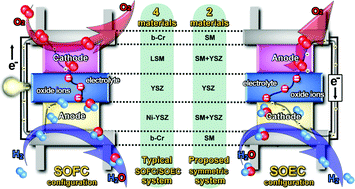Symmetric and reversible solid oxidefuel cells
Abstract
In the past few years a novel concept of Solid

* Corresponding authors
a
Dpto. Química Inorgánica. Universidad de La Laguna, Avda. Astrofísico Francisco Sánchez s/n, CP, Tenerife, Spain
E-mail:
jcruiz@ull.es
b
Dpto. de Física Aplicada I, Universidad de Málaga, 29071-Málaga, Spain
E-mail:
damarre@uma.es
c
Instituto de Energías Renovables, Parque Científico y Tecnológico de Albacete, Universidad de Castilla la Mancha, Albacete, Spain
E-mail:
Jesus.Canales@uclm.es
d
School of Chemistry, University of St Andrews, North Haugh, St Andrews, UK KY16 9ST
E-mail:
jtsi@st-and.ac.uk
In the past few years a novel concept of Solid

 Please wait while we load your content...
Something went wrong. Try again?
Please wait while we load your content...
Something went wrong. Try again?
J. C. Ruiz-Morales, D. Marrero-López, J. Canales-Vázquez and J. T. S. Irvine, RSC Adv., 2011, 1, 1403 DOI: 10.1039/C1RA00284H
To request permission to reproduce material from this article, please go to the Copyright Clearance Center request page.
If you are an author contributing to an RSC publication, you do not need to request permission provided correct acknowledgement is given.
If you are the author of this article, you do not need to request permission to reproduce figures and diagrams provided correct acknowledgement is given. If you want to reproduce the whole article in a third-party publication (excluding your thesis/dissertation for which permission is not required) please go to the Copyright Clearance Center request page.
Read more about how to correctly acknowledge RSC content.
 Fetching data from CrossRef.
Fetching data from CrossRef.
This may take some time to load.
Loading related content
